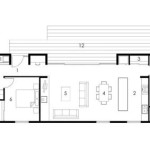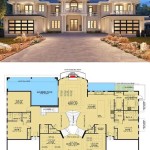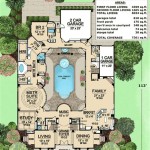Sustainable house plans prioritize the efficient use of resources, minimizing ecological impact while ensuring occupant comfort. These plans incorporate strategies that reduce energy consumption, optimize water conservation, and promote indoor air quality. For instance, a sustainable house plan may feature passive solar design, which utilizes the sun’s energy to heat the home, minimizing the need for conventional heating systems.
By adopting sustainable construction practices, homeowners can contribute to environmental preservation and enjoy the benefits of reduced utility costs. Sustainable house plans often incorporate renewable energy sources such as solar panels or geothermal heating, further minimizing reliance on non-renewable energy sources.
In the following sections, we will delve into the key elements of sustainable house plans, exploring design strategies, materials, and technologies that promote environmental sustainability and occupant well-being.
Sustainable house plans prioritize environmental responsibility and occupant well-being. Key considerations include:
- Passive solar design
- Energy efficiency
- Water conservation
- Renewable energy sources
- Sustainable materials
- Indoor air quality
- Waste reduction
- Resilience to climate change
- Cost-effectiveness
- Aesthetics
By incorporating these elements, sustainable house plans create homes that are environmentally friendly, comfortable, and affordable.
Passive solar design
Passive solar design is a strategy that utilizes the sun’s energy to heat a home, reducing the need for conventional heating systems and lowering energy costs. This approach involves carefully orienting the home on the building site, maximizing exposure to sunlight during the winter and minimizing it during the summer.
- Orientation: The home is positioned so that the largest windows face south (in the Northern Hemisphere) or north (in the Southern Hemisphere). This allows the sun’s rays to penetrate the home during the winter months, warming the interior. In the summer, the sun’s rays are higher in the sky and do not directly enter the home, preventing overheating.
- Window placement: Windows are strategically placed to capture sunlight and distribute it evenly throughout the home. South-facing windows are essential for passive solar design, but east- and west-facing windows can also be used to supplement sunlight exposure.
- Thermal mass: Materials with high thermal mass, such as concrete, stone, or brick, are used to absorb and store the sun’s heat. These materials release heat slowly, providing warmth during the night and on cloudy days.
- Insulation: Proper insulation is crucial to prevent heat loss during the winter and heat gain during the summer. Insulating the roof, walls, and foundation helps maintain a comfortable indoor temperature.
Passive solar design offers numerous benefits, including reduced energy consumption, lower utility bills, improved indoor comfort, and a smaller carbon footprint. By harnessing the power of the sun, sustainable house plans with passive solar design create comfortable and environmentally friendly homes.
Energy efficiency
Energy efficiency is a crucial aspect of sustainable house plans, as it reduces the amount of energy required to operate the home, leading to lower utility bills and a smaller carbon footprint.
- Appliance efficiency: Choosing energy-efficient appliances, such as ENERGY STAR-certified models, can significantly reduce energy consumption. Look for appliances with high energy efficiency ratings when purchasing refrigerators, dishwashers, washing machines, and other household appliances.
- Lighting: LED and CFL bulbs are far more energy-efficient than traditional incandescent bulbs. By switching to energy-efficient lighting, homeowners can reduce their lighting energy consumption by up to 80%. Additionally, installing motion sensors or timers can further reduce energy waste.
- Heating and cooling: Heating and cooling account for a significant portion of a home’s energy consumption. Sustainable house plans incorporate energy-efficient heating and cooling systems, such as heat pumps, geothermal systems, and radiant floor heating. These systems provide efficient and comfortable temperature control while minimizing energy usage.
- Air sealing and insulation: Air leaks and poor insulation can lead to significant heat loss during the winter and heat gain during the summer, increasing energy consumption. Sustainable house plans prioritize air sealing and insulation to minimize air leakage and improve the thermal performance of the building envelope.
By incorporating energy-efficient measures into the design, sustainable house plans create homes that are comfortable, cost-effective, and environmentally friendly.
Water conservation
Water conservation is essential for sustainable house plans, as it reduces the strain on water resources and lowers water bills. Sustainable house plans incorporate water-efficient fixtures and appliances, as well as rainwater harvesting systems, to minimize water consumption.
- Low-flow fixtures: Installing low-flow toilets, showerheads, and faucets can significantly reduce water usage. Low-flow toilets use less than 1.6 gallons per flush, while low-flow showerheads use less than 2.5 gallons per minute. Faucets with aerators can also reduce water flow without sacrificing water pressure.
- Water-efficient appliances: Choosing water-efficient appliances, such as ENERGY STAR-certified washing machines and dishwashers, can further reduce water consumption. These appliances use less water to complete their cycles, saving both water and energy.
- Rainwater harvesting: Rainwater harvesting systems collect and store rainwater for non-potable uses, such as watering the lawn, washing the car, or flushing toilets. This can significantly reduce the reliance on municipal water sources, especially in areas with water scarcity.
- Landscaping: Sustainable house plans often incorporate drought-tolerant landscaping, which requires less water to maintain. Native plants and xeriscaping techniques can help reduce water consumption while enhancing the beauty of the landscape.
By incorporating water-efficient measures into the design, sustainable house plans create homes that are environmentally friendly and cost-effective.
Renewable energy sources
Renewable energy sources play a vital role in sustainable house plans, as they reduce reliance on fossil fuels and minimize greenhouse gas emissions. Several renewable energy options are available for homes, each with its advantages and considerations.
Solar energy
Solar energy is one of the most popular renewable energy sources for homes. Photovoltaic (PV) panels convert sunlight directly into electricity, which can be used to power the home or feed into the grid. Solar energy is a clean, sustainable source of energy that can significantly reduce electricity bills.
Wind energy
Wind energy is another renewable energy option for homes, especially in areas with consistent wind patterns. Wind turbines convert the kinetic energy of the wind into electricity. While wind energy can be intermittent, it can be a valuable source of renewable energy when combined with other renewable sources or energy storage systems.
Geothermal energy
Geothermal energy utilizes the heat from the earth’s core to provide heating and cooling for homes. Geothermal heat pumps circulate a fluid through underground pipes to absorb heat from the earth in the winter and reject heat into the earth in the summer. Geothermal energy is a reliable and efficient source of renewable energy that can significantly reduce energy costs.
Hydropower
Hydropower is a renewable energy source that utilizes the energy of flowing water to generate electricity. While hydropower is typically associated with large-scale dams, small-scale hydropower systems can be used to generate electricity for homes located near rivers or streams.
Incorporating renewable energy sources into sustainable house plans reduces reliance on fossil fuels, minimizes greenhouse gas emissions, and promotes energy independence. By harnessing the power of nature, sustainable house plans create homes that are environmentally friendly, cost-effective, and resilient.
Sustainable materials
Sustainable materials are an essential aspect of sustainable house plans, as they minimize environmental impact, promote occupant health, and contribute to a more sustainable built environment.
Recycled and reclaimed materials
Using recycled and reclaimed materials reduces the demand for new materials, conserving natural resources and diverting waste from landfills. Recycled materials, such as recycled steel, glass, and plastic, can be used in various building components, including structural elements, insulation, and flooring. Reclaimed materials, such as salvaged lumber and vintage fixtures, give new life to old materials while preserving their unique character.
Renewable and rapidly renewable materials
Renewable materials, such as bamboo, cork, and wool, are sourced from plants or animals that can be replenished naturally. Rapidly renewable materials, such as fast-growing trees and grasses, have a short growth cycle, ensuring their sustainability. These materials can be used for flooring, cabinetry, and other building components, providing a sustainable alternative to traditional materials.
Low-VOC materials
Volatile organic compounds (VOCs) are harmful chemicals that can be emitted from building materials and finishes. Low-VOC materials, such as paints, sealants, and adhesives, minimize the release of these chemicals, improving indoor air quality and reducing the risk of health issues associated with VOC exposure.
Durable and low-maintenance materials
Durable and low-maintenance materials reduce the need for frequent repairs and replacements, minimizing waste and environmental impact. Durable materials, such as fiber cement siding and metal roofing, withstand harsh weather conditions and require minimal maintenance. Low-maintenance materials, such as engineered hardwood flooring and quartz countertops, are easy to clean and maintain, reducing the need for harsh chemicals and excessive cleaning.
Incorporating sustainable materials into house plans promotes environmental sustainability, occupant health, and cost-effectiveness. By choosing materials that are recycled, renewable, low-VOC, durable, and low-maintenance, sustainable house plans create homes that are healthy, environmentally friendly, and built to last.
Indoor air quality
Indoor air quality (IAQ) is a crucial aspect of sustainable house plans, as it directly impacts the health and well-being of occupants. Sustainable house plans prioritize strategies and materials that promote clean and healthy indoor air.
Ventilation
Proper ventilation is essential for maintaining good IAQ. Sustainable house plans incorporate natural ventilation strategies, such as operable windows, doors, and skylights, to allow for fresh air exchange. Mechanical ventilation systems, such as energy recovery ventilators (ERVs) and heat recovery ventilators (HRVs), can also be used to circulate fresh air while minimizing heat loss or gain.
Low-VOC materials
Volatile organic compounds (VOCs) are harmful chemicals that can be emitted from building materials, finishes, and furnishings. Sustainable house plans specify low-VOC materials, such as paints, sealants, adhesives, and flooring, to minimize the release of these chemicals into the indoor environment. Low-VOC materials contribute to improved IAQ and reduce the risk of health issues associated with VOC exposure.
Moisture control
Excess moisture can lead to mold growth and other IAQ problems. Sustainable house plans incorporate moisture control strategies, such as proper drainage, vapor barriers, and dehumidifiers, to prevent moisture accumulation and maintain a healthy indoor environment.
Air filtration
Air filtration systems can remove pollutants, allergens, and other particles from the air. Sustainable house plans may include air filters in HVAC systems or standalone air purifiers to improve IAQ and reduce the risk of respiratory issues.
By prioritizing indoor air quality, sustainable house plans create homes that are healthy and comfortable for occupants, reducing the risk of health issues and promoting overall well-being.
Waste reduction
Waste reduction is a critical aspect of sustainable house plans, as it minimizes the environmental impact associated with construction and demolition waste, promotes resource conservation, and contributes to a more circular economy.
Design for deconstruction
Sustainable house plans consider the end-of-life stage of the building by incorporating design principles that facilitate deconstruction. Deconstruction involves carefully dismantling a building to recover and reuse materials, reducing the amount of waste sent to landfills. Design strategies for deconstruction include using standardized and modular components, avoiding the use of adhesives and hazardous materials, and providing clear instructions for disassembly.
Recyclable and reusable materials
Sustainable house plans specify recyclable and reusable materials to minimize waste and promote a circular economy. Recyclable materials, such as metal, glass, and plastic, can be processed and transformed into new products. Reusable materials, such as formwork and scaffolding, can be used multiple times on different construction projects, reducing waste and saving resources.
Waste management plan
A comprehensive waste management plan is an essential part of sustainable house plans. The plan outlines strategies for waste reduction, recycling, and disposal during construction and occupancy. By implementing waste sorting systems, partnering with recycling facilities, and reducing packaging waste, sustainable house plans minimize the amount of waste sent to landfills.
Life-cycle assessment
Life-cycle assessment (LCA) is a tool used to evaluate the environmental impact of a building over its entire life cycle, from raw material extraction to end-of-life disposal. Sustainable house plans incorporate LCA to identify opportunities for waste reduction and minimize the overall environmental footprint of the building.
Through waste reduction strategies, sustainable house plans promote resource conservation, minimize environmental impact, and contribute to a more sustainable built environment. By considering the end-of-life stage and incorporating design principles that facilitate deconstruction, utilizing recyclable and reusable materials, implementing waste management plans, and conducting life-cycle assessments, sustainable house plans create homes that are environmentally friendly, resource-efficient, and built to last.
Resilience to climate change
Sustainable house plans prioritize resilience to climate change by incorporating design and construction strategies that enhance the building’s ability to withstand and recover from extreme weather events and climate-related impacts.
Extreme weather preparedness
Sustainable house plans consider the potential impacts of extreme weather events, such as hurricanes, wildfires, and floods. Design features that enhance extreme weather preparedness include reinforced structures, impact-resistant windows and doors, and fire-resistant materials. Additionally, sustainable house plans may incorporate backup power systems, such as solar panels and batteries, to ensure continued operation during power outages caused by extreme weather.
Climate adaptation strategies
Sustainable house plans incorporate climate adaptation strategies to address the long-term effects of climate change, such as rising sea levels, increased temperatures, and changes in precipitation patterns. Design strategies for climate adaptation include elevating the building above floodplains, using drought-tolerant landscaping, and installing rainwater harvesting systems to mitigate the effects of water scarcity. Additionally, sustainable house plans may consider the use of passive cooling techniques, such as natural ventilation and shading, to reduce energy consumption and adapt to warmer temperatures.
Energy resilience
Sustainable house plans prioritize energy resilience to ensure the availability of power during and after extreme weather events. This can be achieved through the integration of renewable energy sources, such as solar panels and wind turbines, and the installation of backup power systems. Energy resilience measures reduce reliance on the grid and enhance the building’s ability to operate independently during power outages.
Water security
Sustainable house plans incorporate water security measures to ensure access to clean water during and after extreme weather events. This can include installing rainwater harvesting systems, using low-flow fixtures and appliances, and implementing drought-tolerant landscaping. Water security measures reduce the building’s reliance on municipal water sources and enhance its resilience to water shortages caused by climate change.
By incorporating resilience to climate change into sustainable house plans, homeowners can create homes that are better equipped to withstand and recover from the impacts of climate change, ensuring the comfort and safety of occupants and reducing the long-term financial and environmental costs associated with climate change.
Cost-effectiveness
Sustainable house plans are often perceived as more expensive than conventional house plans. However, in the long run, sustainable house plans can be cost-effective due to several factors:
Reduced energy costs: Sustainable house plans incorporate energy-efficient features, such as high-performance insulation, energy-efficient appliances, and renewable energy sources. These features reduce energy consumption, resulting in lower utility bills over the life of the home.
Lower maintenance costs: Sustainable house plans use durable and low-maintenance materials, such as fiber cement siding, metal roofing, and engineered hardwood flooring. These materials require less frequent repairs and replacements, reducing maintenance costs and extending the life of the home.
Increased property value: Sustainable house plans are becoming increasingly desirable in the real estate market. As more homebuyers prioritize energy efficiency and environmental sustainability, sustainable house plans can command higher resale values.
Long-term savings: While the initial construction costs of a sustainable house plan may be slightly higher than a conventional house plan, the long-term savings in energy costs, maintenance costs, and increased property value often outweigh the upfront investment.
Additionally, there are financial incentives available to encourage the construction of sustainable homes. Many governments and utilities offer tax credits, rebates, and other financial incentives to homeowners who build or renovate their homes to meet certain energy efficiency and sustainability standards. These incentives can further reduce the cost of sustainable house plans.
Overall, while the upfront costs of sustainable house plans may be slightly higher, the long-term savings, increased property value, and environmental benefits make them a cost-effective choice for homeowners who prioritize sustainability and financial responsibility.
Aesthetics
Sustainable house plans not only prioritize environmental responsibility and occupant well-being but also consider aesthetic appeal. Sustainable design principles can be harmoniously integrated with visually pleasing elements to create homes that are both eco-friendly and aesthetically captivating.
- Natural materials and textures: Sustainable house plans often incorporate natural materials such as wood, stone, and bamboo, which bring warmth and organic beauty to the home. These materials can be used in flooring, cabinetry, countertops, and other elements to create a connection to nature and enhance the overall aesthetic appeal.
- Large windows and natural light: Sustainable house plans prioritize natural light to reduce the need for artificial lighting and create a brighter, more inviting living environment. Large windows and skylights allow ample daylight to penetrate the home, reducing energy consumption while enhancing the aesthetic appeal by creating a sense of spaciousness and openness.
- Indoor-outdoor connection: Sustainable house plans often blur the boundaries between indoor and outdoor spaces to create a seamless connection with nature. Large windows, sliding glass doors, and outdoor living areas allow occupants to enjoy the benefits of natural light and fresh air while expanding the perceived living space and enhancing the aesthetic appeal of the home.
- Green roofs and vertical gardens: Green roofs and vertical gardens not only contribute to sustainability by reducing energy consumption and improving air quality but also add a unique and visually appealing element to the home. These living walls and rooftop gardens bring a touch of nature to urban environments and create a lush, inviting aesthetic.
By incorporating these aesthetic considerations into sustainable house plans, architects and designers can create homes that are not only environmentally responsible but also visually stunning, enhancing the overall quality of life for occupants.










Related Posts








